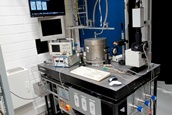High pressure cell 2

Aim
For studying gaseous flows, fuel distributions or mixing processes, often a mixture of fluorescence tracers in a non-fluorescing environment is used to visualize the gas flow, e.g., via laser-induced fluorescence (LIF). Most tracers show significant dependence of their fluorescence yield on pressure, temperature and gas composition. For quantitative analysis of LIF measurements these fluorescence properties of the tracers for defined conditions need to be known. The fluorescence properties of standard fuels – which often fluoresce following excitation by uv-laser radiation – are also of great interest. With this information it is possible to optimize combustions processes and to minimize pollutants using these novel laser-diagnostics approaches.
Approach
Regulated mass flows of the relevant gases are introduced into the cell in a flow configuration. The cell is designed for a pressure range up to 40 bar and a temperature range from room temperature to 550°C and is equipped with four quartz windows. The cell is located inside an oven to ensure a homogenous temperature distribution. The gas flow is mixed with a small, well controlled flow of the respective vaporized tracer using an evaporation system. A second gas flow and a gas mixing chamber allow different gas compositions to be delivered. The substances are optically excited by radiation from excimer lasers or frequency-converted Nd:YAG laser beams. As detection system an ICCD camera with spectrograph is available. For fluorescence lifetime measurements via time-correlated single photon counting (TCSPC) a high repetition rate short-pulse laser and a fiber sensor can be mounted after minor modifications of the setup.
References
F. Zimmermann, W. Koban, C. M. Roth, D.-P. Herten, and C. Schulz "Fluorescence lifetime of gas-phase toluene at elevated temperatures," Chem. Phys. Lett. 426, 248-251 (2006).
Contact
Dr. T. Endres, Torsten Endres , Tel +49 (0)203 - 379 3505, IVG
